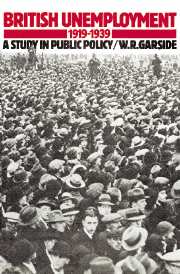Book contents
- Frontmatter
- Contents
- List of tables
- Preface
- Acknowledgements
- PART I INTRODUCTION
- PART II THE LABOUR MARKET UNDER STRAIN
- 2 Defensive action: unemployment relief and public assistance, 1919–1932
- 3 Means to an end: insurance, assistance and the categorization of the unemployed, 1932–1939
- 4 In and out of the labour market: hours of work, pensions and the school-leaving age
- PART III THE INTERNATIONAL CONTEXT
- PART IV STRUCTURAL UNEMPLOYMENT, INDUSTRY AND THE REGIONS
- PART V MACROECONOMIC POLICY OPTIONS: THEORY AND PRACTICE
- Bibliography
- Index
2 - Defensive action: unemployment relief and public assistance, 1919–1932
Published online by Cambridge University Press: 21 September 2009
- Frontmatter
- Contents
- List of tables
- Preface
- Acknowledgements
- PART I INTRODUCTION
- PART II THE LABOUR MARKET UNDER STRAIN
- 2 Defensive action: unemployment relief and public assistance, 1919–1932
- 3 Means to an end: insurance, assistance and the categorization of the unemployed, 1932–1939
- 4 In and out of the labour market: hours of work, pensions and the school-leaving age
- PART III THE INTERNATIONAL CONTEXT
- PART IV STRUCTURAL UNEMPLOYMENT, INDUSTRY AND THE REGIONS
- PART V MACROECONOMIC POLICY OPTIONS: THEORY AND PRACTICE
- Bibliography
- Index
Summary
The dominant response of every interwar government to large-scale and persistent unemployment was to provide cash benefits to the out-of-work, pending a revival in the demand for labour. The scale and duration of such payments, the circumstances in which they were introduced, the conditions under which they could be obtained and the impact which such a response had upon national finances were but some of the issues which kept unemployment relief at the centre of the interwar policy debate. For much of that period the crisis of unemployment and the crisis of unemployment insurance seemed but mirror reflections of one another, each a damning indictment of the failure of successive administrations to respond with any firm political conviction to the serious industrial and economic difficulties that confronted them.
The legal and administrative apparatus deployed for the payment of unemployment benefit had its origins in the Edwardian period. Before 1911 there was no provision at national level for meeting the immediate needs of the unemployed. Out-of-work benefits were available to members of selected trade unions, predominantly covering skilled workers. Outside of private charity, the remainder of the unemployed, at least in England and Wales, were forced to rely on relief from Poor Law Guardians.
- Type
- Chapter
- Information
- British Unemployment 1919–1939A Study in Public Policy, pp. 31 - 65Publisher: Cambridge University PressPrint publication year: 1990
- 1
- Cited by



